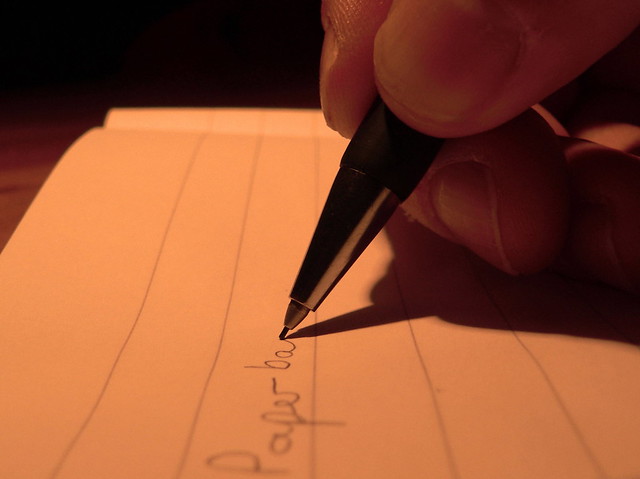 |
| Photo credit: mark lorch on Flickr |
While working on a WIP a couple years ago, my CP at the time pointed out to me that my teenage boy protagonist was having some rather un-teenage-boy-like thoughts.
The problem was that some of the flowery analogies and purplish prose I had used were clashing with his voice, and she challenged me to ask myself if he would really think that.
Since then, I have become much more aware of how my characters think and act, down to their choice of words and mannerisms. But one of the best aspects I took away from that CP comment, to me, actually applies to description.
You see, when writing in first person, or even limited or close third, it’s very important to always keep the character in mind, but not just in the sense of getting to know them and perfecting their voices. You need to be able to climb into their heads and not only imagine the scene from their eyes in the sense of how they will react to their situation or their actions thereafter, but pin down what they notice when writing description.
For a long time I thought of description as a sort of third-party affair. It was something I needed to include in order for the readers to understand where the action was taking place, but until my CP made that comment about my protagonist, I didn’t realize that it was much more than that.
Because when you’re writing a story from a character’s POV, you need to filter the entire story from his or her POV. And that includes description.
So when I talk about writing description through character, I mean that you need to think about not just what it is that you’re describing, but what your POV character would notice about it.
For example, a poor character entering his neighbor’s run-down home would probably notice the smell of food cooking in the kitchen, or pictures on the walls, or some of the items scattered around the house. A rich character entering that same home, however, would likely notice how small everything was, the cracks in the walls, the peeling paint, and buckets for catching rainwater from the leaky ceilings. Their perspectives are different, and because of that, they would notice different details about the same place.
This works the same way for character descriptions as well, in the cases of characters describing another character. Here’s a great example from John Updike’s short story “A&P”:
“She was the queen. She kind of led them, the other two peeking around and making their shoulders round. She didn't look around, not this queen, she just walked straight on slowly, on these long white prima donna legs. She came down a little hard on her heels, as if she didn't walk in her bare feet that much, putting down her heels and then letting the weight move along to her toes as if she was testing the floor with every step, putting a little deliberate extra action into it.”
What I love about this example (and the rest of the examples scattered throughout the text), is that rather than giving us a laundry list of descriptions, we get the full description from the POV character’s mind. The first thing he notices about this particular girl isn’t her hair or eye color, it’s her long prima donna legs and the way she walks. The whole short story is full of the kind of description through character I’m talking about, so if you’re interested, you can read the whole thing here.
So next time you write a description from anything other than an omniscient POV, take the time to consider what your POV character would notice first, and what tidbits he or she may ignore. The extra thought may be exactly what you need to write an interesting, unique description.
Do you write your descriptions through your characters?
Twitter-sized bites:
What is description through character and why is it important? Writer @Ava_Jae explains. (Click to tweet)
Do you write your descriptions through the lens of your character? Here's why you should. (Click to tweet)








6 comments:
Excellent post. Very true. :)
Thank you, Melissa! ^_^
This is seriously so true. I love how your CP really challenged you to think this way, a lot of times when we're critiquing, we have no idea what little comment will affect another person's writing journey. But anyways, it makes so much sense that perspective is the name of the game. This is something I'll be keeping in mind as I write! <3
I agree, Aneeqah! It was a tough pill to swallow when I first saw the comment, but I'm so glad that she brought it up, because it definitely made me a better writer. Perspective is enormously important.
I wish you all the best with your writing!
Excellent point you make here, and something that I'm really focusing on as I'm editing my MS. My CPs have given me some feedback right along the lines of the content of this post. ;-)
Also, I'm learning that this description-through-the-character's-eyes thing can sometimes help with the showing-versus-telling issue of description. Like your example from Updikes' story - we learn about the character doing the describing as well as learning about the girl being described. Much more of a showing description than "the girl had long legs. She walked heel-to-toe."
Since I know I can be prone to long, boring, textbookish descriptions, putting these into the characters' observations and voice really helps the flow of the story. :)
Great point about show vs. tell! You're completely right that describing through the character can definitely help resolve some telling issues, particularly related to description. Giving your descriptions a shot of your characters voice is one quick way to make descriptions more vivid, interesting, and definitely less textbookish. :)
Good luck with your edits!
Post a Comment